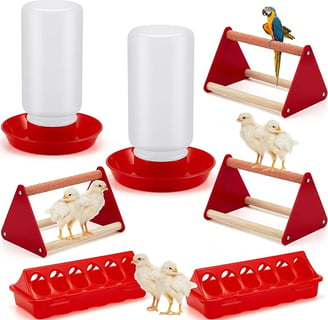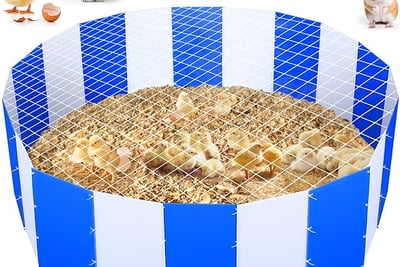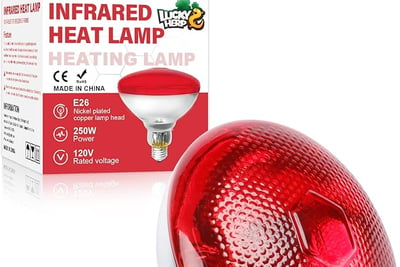How to Set Up a Brooder for Chicks: A Comprehensive Guide
8 min read


Understanding the Purpose of a Brooder
A brooder is a specially designed enclosure that provides a secure and controlled environment for newly hatched chicks. Understanding the essential role of a brooder in the early life of chicks is crucial for successful poultry management. Chicks are vulnerable and require specific conditions to thrive, making the brooder an invaluable tool for every poultry keeper.
The primary purpose of a brooder is to maintain optimal temperature and humidity levels. Newly hatched chicks have limited ability to regulate their body temperature, which makes them highly susceptible to extreme conditions. Typically, a brooder should be kept at a temperature of around 95°F (35°C) during the initial week of life, gradually decreasing it as the chicks grow. This warming effect mimics the conditions provided by a hen, allowing for proper growth and development.
Moreover, humidity control within the brooder is essential. High humidity can lead to respiratory issues, while low humidity can result in dehydration. Therefore, keeping an appropriate balance in humidity levels promotes overall health. Safety is another key factor in brooding. The enclosure must be secure to protect chicks from potential predators and drafts that could lead to illness.
Feeding needs must also be addressed within the brooder. Providing access to clean water and high-quality chick starter feed is critical, as these resources contribute to robust growth and development. Additionally, fostering a clean brooder environment reduces the risk of disease, which can be prevalent in crowded or poorly managed spaces.
In summary, the brooder serves as a fundamental aspect of chick welfare, helping to ensure their health and survival during their formative days. By understanding and implementing proper brooding practices, poultry owners can enhance the overall well-being of their chicks, laying the groundwork for a healthy flock.
Choosing the Right Location for Your Brooder
Establishing the right location for your brooder is a critical step in ensuring the health and safety of your chicks. A suitable environment will facilitate proper temperature control, vital for the development of young birds. First and foremost, seek an area that is sheltered from drafts, as fluctuations in temperature can have detrimental effects on the chicks’ health. Ideally, the brooder should be placed in a location that maintains a steady temperature, away from windows or doors that may allow cold air to seep in.
Another essential factor is access to electrical outlets. Many brooders require heat lamps or heating plates that need a power source. Ensure that the chosen area has easy and safe access to electricity, allowing you to maintain the necessary heat without complicated extensions that could pose a tripping hazard.
Furthermore, cleanliness cannot be overlooked; a clean area is crucial to prevent diseases. Choose a location that is easy to sanitize and keep clean, as this will help reduce the risk of illness among your chicks. In addition to hygiene, good ventilation is important as well. Proper airflow is necessary to maintain a comfortable environment for the chicks, helping prevent respiratory issues that can arise from stagnant air.
Lastly, consider potential distractions and pests. Select a quiet area of your home or farm to minimize stress for the chicks, as excessive noise can be disruptive to their wellbeing. Moreover, it is wise to examine the surroundings for any insects or animals that could pose threats to the chicks. Ensuring the area is pest-free will contribute significantly to the overall safety and health of your young chickens.
Selecting the Appropriate Brooder Setup
Establishing a proper environment for newly hatched chicks is crucial to their survival and growth. When considering a brooder setup, there are various options, including homemade and commercial brooders. Each option has its own advantages and disadvantages depending on your specific needs and circumstances.
Homemade brooders are often a popular choice among poultry enthusiasts for their cost-effectiveness and customization potential. Many individuals repurpose items such as cardboard boxes, plastic bins, or wooden crates. Wood is particularly favored due to its insulation properties, which help maintain a stable temperature. When constructing a brooder, ensuring proper ventilation is essential to prevent moisture buildup and promote airflow. Additionally, choosing materials that are easy to clean and sanitize will help maintain a healthy environment for the chicks.
Commercial brooders, on the other hand, come with pre-designed features that may benefit the caretaker. These ready-made solutions often include built-in heating elements, adjustable vents, and easy access doors for feeding and cleaning. They are typically designed with specific sizes and shapes tailored to the needs of young chickens. For instance, circular or rectangular brooders can increase accessibility while allowing for adequate space for chicks to move and feed comfortably. Size considerations are paramount; each chick requires around 0.5 to 1 square foot of space to thrive during the initial weeks of their life. Therefore, accurately estimating the number of chicks can guide the decision on the size of the brooder.
Accessibility is another critical factor. An ideal brooder is easily approachable, providing convenience for caretakers when adding food, water, and bedding or when monitoring the chicks. By ensuring that the brooder setup meets these criteria, you can create a nurturing environment that promotes healthy growth for your chicks.
Essential Equipment and Supplies for Your Brooder
Setting up a brooder requires careful consideration of various essential equipment and supplies to ensure the health and safety of your chicks. A heat source is perhaps the most crucial component; without adequate warmth, newly hatched chicks are susceptible to stress and illness. Common heat sources include heat lamps and heating pads. When using heat lamps, it is recommended to select infrared bulbs, as they provide sufficient warmth and light without overheating the brooder. Position the lamp securely at an appropriate height to maintain a temperature range of 90°F to 95°F during the first week, gradually decreasing this as the chicks grow.
Bedding materials are another vital element in creating a suitable environment for your chicks. Pine shavings are generally the preferred option due to their absorbent properties and ability to help control odors. Avoid cedar shavings, as they can be harmful to chicks. Ensure that the bedding is at least two inches deep to provide insulation and comfort. Regularly changing the bedding will help maintain hygiene and reduce the risk of respiratory issues.
Feeders and waterers are indispensable for providing nourishment and hydration. Choose feeders that are designed for young chicks, typically with shallow designs to prevent wastage and droplet obstruction. It is advisable to use waterers that are easy to clean and refill; consider those with anti-drowning features to ensure the chicks' safety. Place feeders and waterers in a location that is easily accessible, while also preventing contamination from bedding materials.
Maintaining a clean and organized brooder environment is essential for the overall well-being of your chicks. Implement a regular cleaning schedule to remove waste, replace bedding, and sanitize feeders and waterers. Regular maintenance not only promotes cleanliness but also enhances the overall effectiveness of your brooder setup, ensuring you create a safe haven for your growing chicks.
Maintaining Temperature and Humidity in the Brooder
Successfully raising chicks requires careful attention to their environmental conditions, particularly temperature and humidity levels within the brooder. Proper monitoring ensures that the chicks remain comfortable and healthy during their early development stages. The ideal temperature for newly hatched chicks is typically set between 90°F to 95°F, and this heats progressively decreases by 5°F each week until they reach about 70°F by the time they are six weeks old. Using a reliable thermometer is essential for accurately gauging these temperatures.
To maintain the correct temperature, several heating methods can be employed, including heat lamps, heating plates, or ceramic heaters. Each method has its merits, but care should be taken to position these heat sources appropriately to avoid creating hotspots or cold drafts. Chicks should be able to move away from the heat source if they are too warm, which is crucial to preventing heat stress. Signs of overheating include excessive panting, lethargy, or distressed behavior, while signs of chilling can manifest in huddling together, peeping loudly, or a decrease in activity level.
Humidity is another important factor in the brooder. A humidity level of 50% to 65% is generally recommended during the first week of a chick's life, which can be monitored using a hygrometer. Maintaining appropriate humidity helps prevent respiratory issues and other health complications. If humidity levels are inadequate, adding a shallow dish of water or using a humidifier can help stabilize moisture levels. Conversely, if humidity is too high, proper ventilation should be ensured to allow for moisture escape.
By closely monitoring both temperature and humidity within the brooder, you can create an optimal environment conducive to the growth and well-being of your chicks. Maintaining these conditions is vital not only in the initial stages after hatching but throughout their early life as they transition into more independent stages of chick development.
Feeding and Watering Your Chicks
Proper nutrition and hydration are vital for the healthy development of chicks. The dietary needs of chicks change as they grow, necessitating different types of feed at various stages. Initially, chicks require a high-protein starter feed, typically containing around 18-20% protein, which supports their rapid growth rate. This starter feed is designed to provide essential nutrients and vitamins that are crucial during the initial weeks of life.
As the chicks progress to around 8 weeks old, they transition to a grower feed, which usually contains a lower protein content of approximately 16-18%. This gradual shift helps promote solid growth and prepares the chicks for eventual maturation. It is also important to provide grit, especially if you introduce kitchen scraps or foraging opportunities, as it aids in digestion.
Water is equally critical for the chicks’ health. Always ensure that they have access to clean and fresh water. Using shallow dishes or specialized chick waterers can help prevent drowning while facilitating easy access for the chicks. It's crucial to regularly check and refill the water source to prevent contamination and ensure hydration.
Setting up feeders and waterers requires careful consideration to mitigate spillage and waste. Elevated feeders can help prevent excess food from being scattered, while placing the feeders away from the water sources minimizes the risk of feed contamination. Additionally, ensuring that both feeders and waterers are well-maintained will promote a healthy environment for the growing chicks.
Providing a balanced diet along with adequate hydration is essential not only for the physical development of the chicks but also for establishing a healthy and thriving flock. By understanding their nutritional requirements and ensuring they have the necessary resources, you will set the stage for their long-term well-being.
Transitioning Chicks from Brooder to Coop
Transitioning chicks from the brooder to their permanent coop is a crucial step in their development and requires careful consideration. The timing of this transition is primarily influenced by the chicks' age, feather development, and the ambient temperature. Generally, chicks can begin the move when they are around six weeks old, as this is when they start to develop feathers that can help regulate their body temperature.
Chick behavior also serves as a key indicator of readiness for coop life. Observing how the chicks interact with their environment within the brooder can provide insight. If they are consistently showing signs of restlessness or exploring their space eagerly, it may signify that they are ready for the next stage. Additionally, at this age, chicks will be better able to cope with cooler temperatures, assuming the coop is adequately insulated and draft-free.
Before making the transition, it is critical to prepare the coop to ensure a seamless move. The coop should be predator-proof, clean, and well-ventilated. Adequate nesting boxes, perches, and room for movement are vital for promoting well-being in the new environment. Proper bedding, such as straw or wood shavings, should be laid down to provide familiarity and comfort. It is beneficial to introduce the chicks to the coop gradually. Start by allowing them to explore the coop during the day while returning to the brooder at night. This method helps the chicks acclimate to their new surroundings without overwhelming them.
Additionally, monitoring the chicks closely during their transition period is advisable. Keep an eye on their behavior and health, ensuring they adjust well to their new habitat. Gradually increasing their time in the coop can ease the transition while providing insights into their adaptation to life beyond the brooder.











